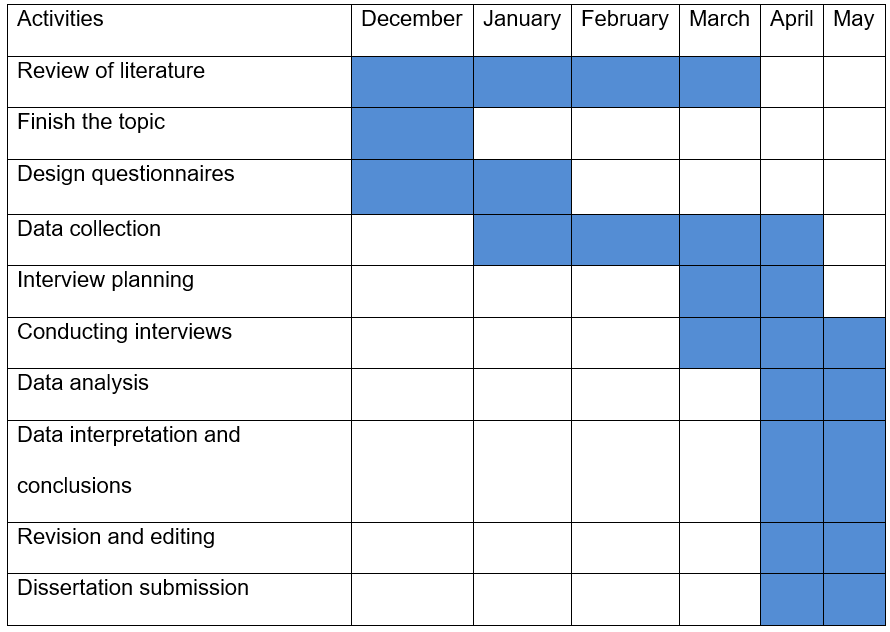Abstract
Motivation is a key driver in many organizations and is essential in the management of employees. Motivation determines what employees choose to do and how much effort and time they put in completing a task. Motivating employees play a major role in shaping organizational behavior.
Description of the Project
The purpose of this study is to determine the impact of motivation on organizational behavior. This study will be a census of all employees at ABC Company.
Statement of the Problem
Researchers have analyzed that many factors can affect organizational performance; motivation is one of them. This study looks at the impact of motivation on organizational behavior.
Basic Objectives
The study will be guided by the following objectives
- To establish the relationship between motivation and organizational performance.
- To determine the level of motivation of employees of ABC Company
- To determine the effectiveness of motivation practices adopted by ABC Company.
Research Questions
The research will seek to answer the following research questions
- What is the relationship between motivation and organizational behavior?
- What is the level of motivation of employees of ABC Company?
- How effective are the motivation practices adopted by ABC Company?
Literature Review
There are various studies about motivators that could play a role in improving organizational behavior. These motivators include job design, style of leadership and recognition. Organizations design motivation systems to encourage employees to perform most effectively. Motivation factors differ among various groups of people. The Hawthorne studies by Elton Mayo indicate that organizational performance and motivation increase when the focus is placed on the employees. Identifying the importance of employee needs plays a role in conceptualizing aspects of motivation and consequently influencing organizational behavior. Taylor’s theory of motivation posits that work is related to rewards and penalties which are directly connected to performance (Armstrong, 2007). Research, on the contrary, indicates that highly motivated people are scared of failure and therefore may be complacent thus leading to low organizational performance (Pinder, 1998).
Basic Information Sources
The researcher will use data from primary and secondary sources. Primary data will be obtained directly from the field through the use of questionnaires and structured interviews. Secondary data is applied to facts and assumptions from documented materials. Secondary data will be gathered from periodicals, web-based documents, and any other printed articles.
Research Strategy and Methodology
The methodology of this research is designed to gather data on the impact of motivation on organizational behavior. This study will adopt a descriptive survey which is an appropriate way of collecting data to test a hypothesis or study the current state of objects. Descriptive studies have a broad appeal to managers for planning and monitoring policies. It is precisely because it involves describing events in a systematic manner (Babbie, 2005). The study will integrate both qualitative and quantitative methods of research. Qualitative analysis gives a detailed description in the form of words while quantitative research uses statistical models of research to explain what is observed. The two methods will allow the researcher to get an in-depth understanding of the phenomenon under study (Babbie, 2005).
The population for the study will consist of all 30 employees of ABC Company. They will form the sample for the study. The research will be done through the use of questionnaires and interviews. The researcher will use structured interviews to allow for comparability of results. Interviews allow for probing, and they have a higher response rate. The questionnaires will be mailed to employees of ABC Company for filling and collected in two weeks. The data obtained from the field will be analyzed using Statistical Package for social sciences (SPSS) software. Data has to be analyzed to provide answers to research questions. The findings will then be presented in percentages, cross-tabulations, and charts (Babbie, 2005).
Structure of the Project
The research paper will contain five chapters. Chapter one will discuss the background, the problem statement, objectives, research questions, scope, rationale and significance of the study. Chapter two includes a review of the literature and the conceptual framework for the study. Chapter three will discuss the research methodology by describing the research design, sample size, and data collection methods. Chapter four will entail data analysis and interpretations. Finally, chapter five will give a discussion, conclusions, and recommendations of the study.
Research Plan
The research will be conducted over six months starting December 2013 to May 2014. The timelines of the study are as shown in the table below.

Expected results
The expected results are that the motivation influences organizational behavior positively to a large extent. This means that motivated employees will work efficiently to shape organizational behavior.
Ethical issues
The researcher will ensure that there is no breach of nondisclosure agreements or confidentiality and misinterpretation of results.
References
Armstrong, M. (2007). Employee Reward Management and Practice. London and Philadelphia: Kogan Page.
Babbie, E. (2005). The Basics of Social Research (3rd ed.). Canada: Thomson Wadsworth.
Pinder, C. (1998). Work Motivation in Organizational Behavior. New Jersey: Prentice Hall.